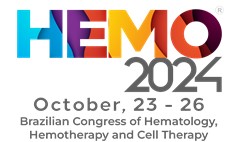
The aim of this study is to evaluate the allogeneic hematopoietic stem cell transplantation data performed in our transplant center for patients diagnosed with Acute Myeloid Leukemia (AML).
Materials and methodsBetween 2016 and 2024, a retrospective evaluation was conducted on 176 patients who underwent allogeneic hematopoietic stem cell transplantation at the Adult Stem Cell Transplant Unit of Private Emsey Hospital due to AML diagnosis.
ResultsThe retrospective analysis of AML patients who underwent allogeneic transplantation revealed an average age of 43.2 years. A total of 130 patients received a related donor transplant, while 46 underwent unrelated donor transplantation. The Turkish National Bone Marrow Donor Bank (TÜRKÖK) was the only source for unrelated donors. HLA allele mismatch (1 allele) was present in 29 donors, and 80 transplants were performed between different genders. The average time for neutrophil engraftment was 17.7 days, and for platelet engraftment, it was 19.5 days. The 100-day mortality rate was determined to be 20%.
ConclusionAML is a hematologic malignancy that can be treated with allogeneic stem cell transplantation. Unrelated donor transplantation is a critical option for patients without a suitable family donor who require allogeneic transplantation. Our center’s AML transplant patient demographic data aligns with the findings in the literature.
Case reportAcute Myeloid Leukemia (AML) is the most common clonal hematopoietic stem cell disorder in adults. Prognosis is assessed based on age, gender, performance status, and cytogenetic mutations. Hematopoietic Stem Cell Transplantation (HSCT) is a widely used treatment method, particularly for hematological malignancies. Allogeneic HSCT offers curative potential for many hematologic malignancies. Transplantation is performed in AML patients to reduce the risk of relapse. A fully HLA-matched related donor is the preferred choice for allogeneic HSCT. However, only about 25% of patients have a fully HLA-matched related donor. In such cases, an allogeneic transplant from an unrelated HLA-matched donor may be performed. This study presents data on allogeneic HSCT procedures performed in our transplant center for AML patients.
MethodologyA retrospective analysis was conducted on allogeneic hematopoietic stem cell transplantations performed between 2016 and 2024 in the Adult Stem Cell Transplant Unit of Private Emsey Hospital for AML patients.
ResultsA total of 176 AML patients who underwent allogeneic transplantation were retrospectively analyzed. The median patient age was 43.2 years (range: 16–72), with 53% (n = 94) being male and 47% (n = 82) female. Two patients (1%) had previously undergone autologous stem cell transplantation, and seven patients (4%) had a history of prior allogeneic transplantation. Among the patients, 130 (74%) underwent HLA-Matched Sibling Donor (MSD) transplantation, while 46 (26%) received an unrelated donor transplant. All unrelated donors were obtained from the Turkish National Bone Marrow Donor Bank (TÜRKÖK). Among the 176 stem cell donors, 29 (16%) had a one-allele HLA mismatch (9/10), while 147 (86%) were fully HLA-matched (6/6 and 10/10). A total of 80 transplants (37%) were performed between different genders. The median age of donors was 39.5 years (range: 14–82). As a conditioning regimen, 107 patients (61%) received myeloablative conditioning, 57 patients (32%) received a non-myeloablative regimen, and 12 patients (7%) received a Reduced-Intensity Conditioning (RIC) regimen. Peripheral blood stem cells were used for all patients, with an average of 6.59 × 10⁶/kg (range: 2.86–15.5 × 10⁶/kg) stem cells infused. Eighteen patients (10%) experienced graft failure, while the remaining 158 patients achieved engraftment, with neutrophil engraftment occurring at a median of 17.7 days (range: 10–32) and platelet engraftment at a median of 19.5 days (range: 10–34). Among the 158 patients who achieved engraftment, chimerism analysis could not be performed in 18 cases. In the remaining 140 patients, chimerism levels ranged from 10% to 100%, with an average of 94%. Full donor chimerism (100%) was observed in 46 patients (33%). Within the first 100 days, 35 patients (20%) died. Among patients who achieved engraftment, 17 (11%) died. The median time to death was 48.2 days (range: 8–94).
ConclusionDespite intensive chemotherapy, 10%–40% of AML patients fail to achieve remission. Even among young adult patients who reach remission, relapse occurs in approximately 50% of cases. In this high-risk group, allogeneic HSCT represents a curative treatment option. Unrelated donor transplantation is particularly valuable for patients requiring allogeneic HSCT who lack a suitable related donor. Our center’s AML allogeneic HSCT patient and donor characteristics, conditioning regimens, engraftment times, and 100-day mortality rates are consistent with findings in the literature.






